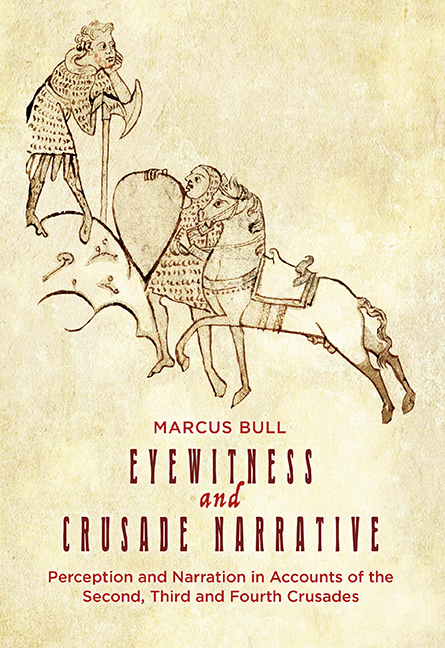 Eyewitness and Crusade Narrative
Eyewitness and Crusade Narrative Published online by Cambridge University Press: 12 February 2019
The history of the Third Crusade known as the Estoire de la Guerre Sainte (c.1195), which is almost certainly to be attributed to an Ambroise who is named no fewer than nine times over the course of the text, commands attention as an eyewitness history for two reasons. It lies at the intersection of important developments in later twelfth-century western historiography; and the text is noteworthy for its supple, multifaceted and creative fashioning of eyewitness authority. As this chapter will argue, eyewitnessing is closely bound up in several of the Estoire's self-authorizing moves. These are, most notably: the construction of the narrator as a close and informed observer; the interplay between individual narratorial perception and attention to collective agency; the co-opting of the reader's or listener's visual imagination in the act of following the narrative; the distribution of focalizing roles, with a particular emphasis on that of King Richard I of England; and, perhaps most importantly, the translation of the immersive experience of participating in the crusade expedition into a number of visually rich diegeses that do not merely punctuate the action in the nature of attention-grabbing vignettes but also programmatically aid the reader's understanding of the story as a whole. In other words, the narrator's ability to speak authoritatively about the course of the crusade is not simply the sum of multiple individual acts of informed and reflective visual perception, significant as these are; it is also a function of his inclusion within numerous collective experiences in which visual sensation is brought to the fore. In this way, and to an even greater degree than the two texts examined in the previous chapter, the Estoire represents an abstracting out of individual eyewitness into a collective experiential register.
Before we examine the Estoire in detail, it is useful to set it in its closely contemporary context. The two narratives of the Second Crusade that we considered above exemplify the challenges posed when one source of necessity dominates our understanding of a given sequence of events. With the Third Crusade (1187–92) we enter a notably fuller evidentiary landscape characterized by a greater number of narratives that were either written by eyewitness participants or were informed, to varying degrees, by eyewitness testimony.
To save this book to your Kindle, first ensure [email protected] is added to your Approved Personal Document E-mail List under your Personal Document Settings on the Manage Your Content and Devices page of your Amazon account. Then enter the ‘name’ part of your Kindle email address below. Find out more about saving to your Kindle.
Note you can select to save to either the @free.kindle.com or @kindle.com variations. ‘@free.kindle.com’ emails are free but can only be saved to your device when it is connected to wi-fi. ‘@kindle.com’ emails can be delivered even when you are not connected to wi-fi, but note that service fees apply.
Find out more about the Kindle Personal Document Service.
To save content items to your account, please confirm that you agree to abide by our usage policies. If this is the first time you use this feature, you will be asked to authorise Cambridge Core to connect with your account. Find out more about saving content to Dropbox.
To save content items to your account, please confirm that you agree to abide by our usage policies. If this is the first time you use this feature, you will be asked to authorise Cambridge Core to connect with your account. Find out more about saving content to Google Drive.